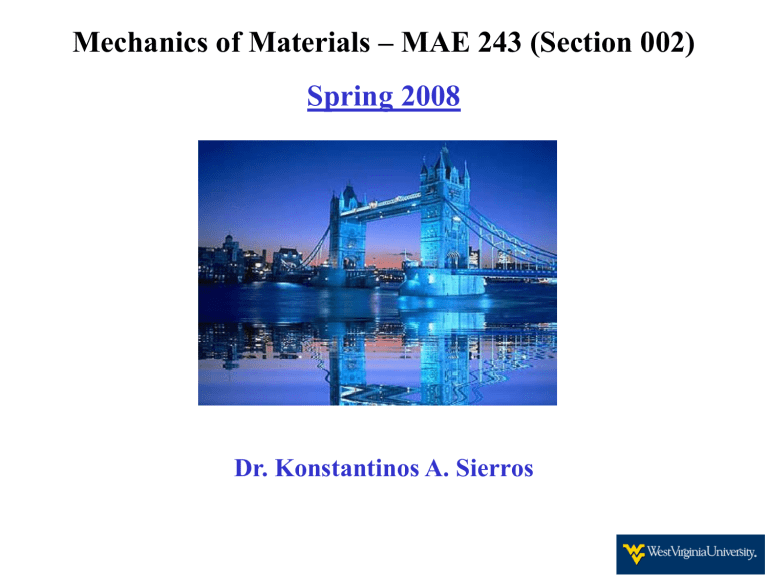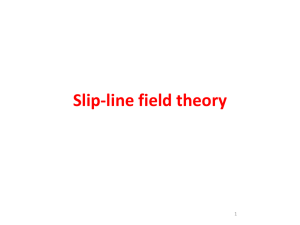Lecture 24

Mechanics of Materials – MAE 243 (Section 002)
Spring 2008
Dr. Konstantinos A. Sierros
7.5: Hooke’s law for plane stress
• Materials that meet two important conditions: 1) The material is uniform throughout the body and has the same properties in all directions (ie homogeneous and isotropic) and 2) The material follows Hooke’s law (ie is linearly elastic)
• For example the strain ε x in the x direction due to the stress σ x is equal to σ x
/E where E is the modulus of elasticity. But we also have a strain ε x due to the stress σ y and is equal to -v σ y
/ E where v is the Poisson’s ratio (see section 1.5)
• Also revise section 3.6
FIG. 7-23
Element of material in plane stress
( z
= 0)
FIG. 7-24
Element of material subjected to normal strains x
, y
, and z
Copyright 2005 by Nelson, a division of Thomson Canada Limited
Copyright 2005 by Nelson, a division of Thomson Canada Limited
7.5: Hooke’s law for plane stress
• Special cases of Hooke’s law
- Biaxial stress: σ x
= σ y
= 0
- Uniaxial stress: σ y
= 0
- Pure shear: σ x
= σ y
= 0, ε x
= ε y
= ε z
= 0 and γ xy
= τ xy
/ G
• Volume change: The change in volume can be determined if the normal strains
In the three perpendicular directions
• Strain – Energy density in plane stress
Revise sections 2.7 and 3.9
7.6:Triaxial stress
• State of triaxial stress
• Since there are no shear stresses on the x,y and z faces, the stresses σ x
,σ y,
σ z are the principal stresses
• If an inclined plane parallel to the z axis is cut through the element (fig 7-
26b), the only stresses on the inclined face are the normal stress σ and shear stress τ, both of which act parallel to the xy plane
FIG. 7-26
Element in triaxial stress
Copyright 2005 by Nelson, a division of Thomson Canada Limited
7.6:Triaxial stress
• The stresses acting on elements oriented at various angles to the x, y and z axes can be visualized using the Mohr’s circle.
• For elements oriented by rotations about the z axis, the corresponding circle is A
• For elements oriented by rotations about the x axis, the corresponding circle is B
• For elements oriented by rotations about the y axis, the corresponding circle is C
FIG. 7-27 Mohr’s circles for an element in triaxial stress
Copyright 2005 by Nelson, a division of Thomson Canada Limited
7.7: Plane strain
• If the only deformations are those in the xy plane, then three strain components may exist – the normal strain ε x in the x direction (fig 7-29b), the normal strain ε y in the y direction (fig 7-29c) and the shear strain γ xy
(fig 7-29d).
An element subjected to these strains (and only these strains) is said to be in a state of plane strain
• It follows that an element in plane strain has no normal strain ε z in the z direction and no shear strains γ xz and γ yz in the xz and yz planes respectively
• The definition of plane strain is analogous to that for plane stress
FIG. 7-29
Strain components x in the xy plane (plane strain)
, y
, and xy
Copyright 2005 by Nelson, a division of Thomson Canada Limited
FIG. 7-30 (1 of 2)
Comparison of plane stress and plane strain
Copyright 2005 by Nelson, a division of Thomson Canada Limited
FIG. 7-30 (2 of 2)
Comparison of plane stress and plane strain
Copyright 2005 by Nelson, a division of Thomson Canada Limited
7.7:Transformation equations for plane strain
• Expression for the normal strain in the x
1 direction in terms of the strains ε x
,
ε y
, ε z
• Similarly the normal strain ε y1 in the y
1 direction is obtained from the above equation by setting θ = θ+90
FIG. 7-32 Deformations of an element in plane strain due to normal strain x normal strain y shear strain xy
Copyright 2005 by Nelson, a division of Thomson Canada Limited
7.7:Transformation equations for plane strain
• we also have…
…which is an expression for the shear strain
γ x1y1
Transformation equations for plane strain







